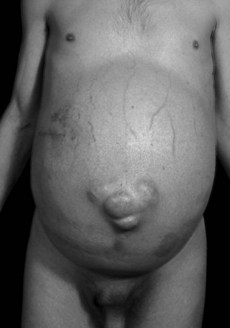115 Ascites
Salient features
Examination
• Full flanks and umbilicus (Fig. 115.1)
• Presence of shifting dullness (always percuss with your finger parallel to the level of fluid)
• If the ascites is gross, use the ‘dipping’ method of palpation to feel the liver and spleen
• Look for stigmata of underlying disease (e.g. signs of cirrhosis, cardiac failure, renal failure or malignancy).
Questions
Advanced-level questions
What are the mechanisms of ascites formation in cirrhosis?
• It is caused by a combination of liver failure and portal hypertension. Liver failure decreases renal blood flow, resulting in retention of salt and water
• Secondary hyperaldosteronism caused by increased renin release and decreased metabolism of aldosterone by the liver
• Decreased metabolism of aldosterone by the liver
• Decreased metabolism of antidiuretic hormone
• Hypoalbuminaemia, which decreases colloid oncotic pressure
• Lymphatic obstruction, resulting in a ‘weeping’ liver
• Overproduction of nitric oxide has been proposed to be important in the pathogenesis of ascites sodium and water retention and hemodynamic abnormalities in cirrhosis (N Engl J Med 1998;339:533–41). Inhibition of nitric oxide synthesis improves sodium and water excretion in cirrhotic rats with ascities.
Stay updated, free articles. Join our Telegram channel

Full access? Get Clinical Tree



